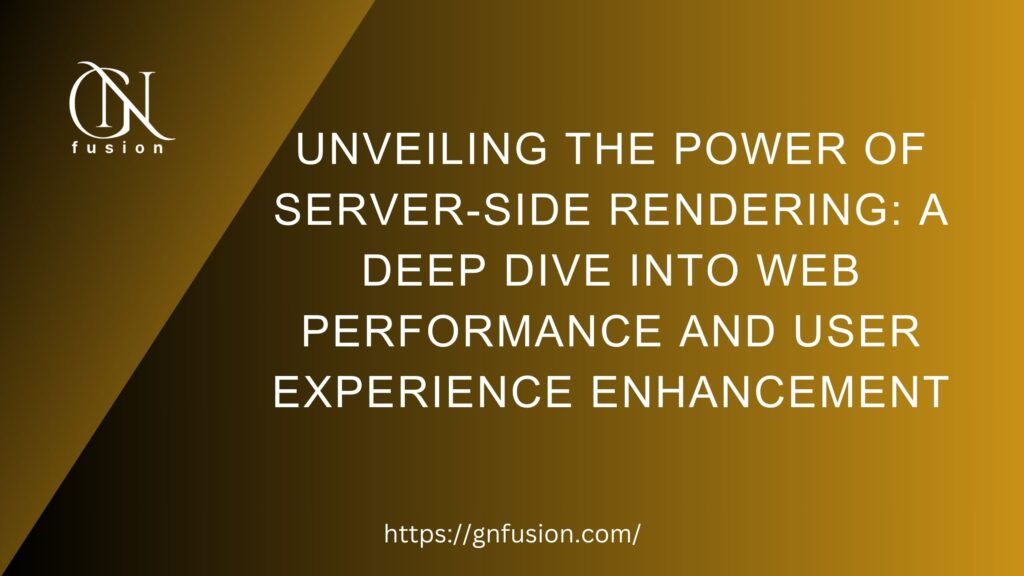Introduction
In the dynamic realm of web development, Server-Side Rendering (SSR) stands as a beacon of innovation, transforming the way we conceive and construct web applications. This comprehensive guide aims to unravel the intricate layers of SSR, shedding light on its unparalleled ability to enhance both web performance and user experience. Brace yourself for a journey into the unexplored facets of SSR, where every word is a revelation.
1: SSR Unveiled – Beyond the Basics
1.1 Defining SSR in the Modern Web Ecosystem
To truly grasp the essence of SSR, we’ll embark on a journey beyond the superficial definitions. Let’s uncover the core principles that make SSR a game-changer, pushing the boundaries of conventional web development.
1.2 SSR: More Than Just Speed
While the speed of rendering is a well-known advantage of SSR, there’s more beneath the surface. We’ll explore how SSR influences user engagement, conversion rates, and the overall user experience in ways you might not have considered.
1.3 The Unexplored Potential of Hybrid Rendering
Hybrid rendering, the amalgamation of SSR and Client-Side Rendering (CSR), is a path less trodden but brimming with potential. We’ll delve into the unexplored territories of hybrid rendering, unveiling its advantages and how it offers a middle ground for diverse web applications.
2: The Technical Marvels of SSR
2.1 SSR Workflow Demystified
Ever wondered how SSR works its magic under the hood? We’ll dissect the SSR workflow, from the initial request to the final paint on the user’s screen. Understanding this process is key to unleashing the full potential of SSR.
2.2 SSR and Web Accessibility
In a digital landscape that increasingly values inclusivity, SSR emerges as a champion for web accessibility. We’ll explore how SSR can contribute to making web applications more accessible, breaking down barriers for users with varying needs.
2.3 SSR and Security: A Robust Alliance
Beyond performance gains, SSR offers a robust security framework. Discover how SSR can fortify your web applications against common vulnerabilities and ensure a secure online environment for users.
3: The SEO Advantage of SSR
3.1 SEO Fundamentals
Unlock the SEO potential of SSR as we delve into the fundamental principles that make SSR a favorite among search engines. From crawlability to indexability, we’ll explore how SSR can give your website the SEO boost it deserves.
3.2 SSR and Core Web Vitals
Google’s Core Web Vitals have become a benchmark for web performance. We’ll investigate how SSR aligns with these vital metrics, ensuring your website not only ranks high in search results but provides an exceptional user experience.
4: SSR Implementation Strategies
4.1 Choosing the Right Framework
The world of SSR is vast, with a myriad of frameworks and libraries. We’ll guide you through the process of selecting the right SSR framework for your project, considering factors like scalability, ease of use, and community support.
4.2 SSR and Progressive Web Apps (PWAs)
PWAs are hailed as the future of web applications, and SSR plays a pivotal role in their development. Explore how SSR contributes to building fast, reliable, and engaging PWAs that users love.
5: SSR in Action – Real-World Case Studies
5.1 Unearthing E-commerce Success
In the competitive e-commerce landscape, speed and user experience are non-negotiable. Discover how leading e-commerce platforms leverage SSR to create seamless shopping experiences and boost conversions.
5.2 Media-Intensive Marvels
From image-rich portfolios to media-heavy news websites, SSR proves its mettle in diverse domains. We’ll dissect case studies showcasing how SSR optimizes performance for content-heavy platforms.
6: Future Horizons of SSR
6.1 Beyond 2023: SSR and Emerging Technologies
Step into the future as we explore the potential convergence of SSR with emerging technologies like WebAssembly, machine learning, and edge computing. What does the future hold for SSR, and how can developers stay ahead of the curve?
6.2 SSR and Augmented Reality (AR)
As AR applications gain momentum, SSR could play a pivotal role in shaping their performance and user experience. Delve into the uncharted territories of SSR in the realm of augmented reality and immersive digital experiences.
Bottom Line
In the labyrinth of web development, Server-Side Rendering emerges as a guiding light, leading us towards unparalleled web performance and user experiences. As we conclude this exploration, remember that SSR is not just a tool; it’s a paradigm shift, a transformative force reshaping the digital landscape. Embrace the power of SSR, and embark on a journey where every rendered pixel tells a story of enhanced performance and delighted users.
If you enjoy this article or find it helpful. Please like, comment, and share this post.


